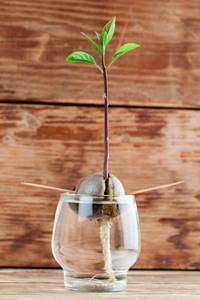New Year, like other celebrations, means a good mood, relaxation of soul and body and, of course, a chic festive table, for which many housewives prepare salads with avocado. The exotic fruit is interesting not only for its delicious, buttery pulp, but also for its large seed, which just begs to be sprouted. How to grow an avocado from a seed at home, is it difficult? Will such an indoor tree bear fruit and how to care for it?
There are many questions, so growing an avocado tree at home is on the agenda. Here are step-by-step recommendations for you on how to prepare an avocado seed for germination, what soil is suitable for planting avocados, proper care of a seedling, a grown tree, and much more.
Will an avocado grown at home from a seed bear fruit?
Avocado has long appeared on the shelves of our stores; finding it is not a problem, but at the same time it remains an exotic fruit about which little is known. Let's explain: avocado is not a vegetable, but a fruit that grows on trees reaching a height of 20 meters.
How does avocado grow in its natural environment?
When growing an avocado on a windowsill, you should keep in mind that this houseplant rarely blooms and bears fruit even less often. At home, the tree reaches a height of 2-3 meters. First of all, when growing an avocado, what is interesting is the process of growing the tree and trying to form a fancy crown.
Avocados are grown at home not for their fruits, but as an interesting decorative element. Thanks to the beautiful lush crown, a cozy atmosphere always reigns in a room with such a tree. The plant does a good job of purifying the air. And this is a hobby for many years, since growing a house requires maximum effort; it will take from three to six years.
Indoor avocado and a plant in nature - what are the differences?
An avocado tree grown at home has a number of features compared to trees growing in natural conditions. It is better to learn about these features before boarding, so as not to be disappointed after.
- It is important to understand that a plant cannot reach even 2-3 meters in an ordinary apartment with standard ceilings. The tree will not be able to even reach the height of the ceiling, since the overall crowding will slow down the growth processes.
- Let us repeat that fruiting is almost impossible. The flowering of a plant is already a huge success. In most cases, seedlings are grown as green ornamental shrubs.
- With some luck and perseverance, it is still possible to achieve fruits, although this happens extremely rarely. This will not happen soon, since the tree is capable of bearing fruit at the age of no earlier than 3-5 years.
- The fruits collected from homemade avocados are edible, but nothing more. The taste of such fruits is incomparable to those fruits that grew on tall trees under the scorching southern sun.
The young tree is very unattractive: a shock of leaves rests on a thin and unformed stem. Don’t let this first impression scare you; very soon the plant will take shape into a real tree in miniature.
Which seed is suitable for germination?
For successful germination, it is important to choose the right fruits, since exotic fruits are often delivered to us unripe. A tree can only be grown from the seed of a ripe fruit. If the avocado is not ripe, wrap it in paper and leave it to ripen.
Choose a fruit based on its appearance; the fruit should be elastic to the touch; with light pressure, the flesh is pressed and restored. If the pulp gives in easily to pressure, the fruit is overripe.
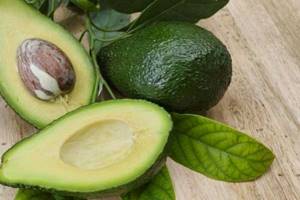
Preparing the avocado seed for germination
In addition to the successful selection of fruits for planting, it is equally important to correctly remove the avocado seed without damaging the integrity of its shell. This can be done quickly and easily if you follow our instructions:
- Cut the avocado in a circle, but not deeply, lightly touching the pit with the blade of the knife.
- Grab the two avocado halves and twist them in opposite directions. In your hands you will have half of the fruit with a seed and the other half without it.
- Using a tablespoon, carefully remove the pit from the avocado. Rinse and dry it. The seed is ready for planting.
How to germinate an avocado seed - open and closed methods
Active plant growth occurs between March and June, so we recommend planting an avocado seed in early February to give it a month to germinate, so that the sprout will enter the growing season. At other times of the year, the seed will also germinate and the seedling will develop, but everything will happen more slowly.
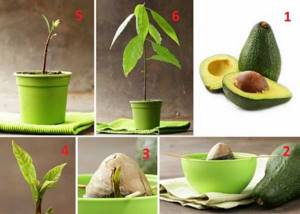
Step by step how to germinate an avocado seed and grow an indoor avocado tree
Before planting, you need to decide in advance on the method of germinating the extracted seed.
Closed germination method
This option is simpler and more traditional. You will need the pit itself, an avocado pot with a drainage hole, drainage and a small amount of fertile soil.
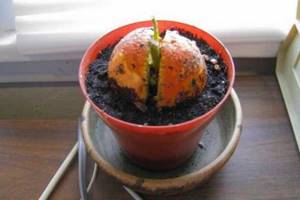
Growing avocado seeds in soil
Pour the drainage into the pot, with a layer of soil on top. Place the avocado pit in the ground with the blunt end, deepening it by 2 cm, the sharp tip should protrude above the ground level.
With proper care, which we will talk about a little later, the seed will take root and sprout in about a month.
Open method of germination
This option is interesting because the process of seed germination will be visible. Before planting in the ground, the seed will need to be germinated in water in a suspended position.
Step by step how to germinate an avocado seed:
- Make 3 or 4 holes in the avocado pit, evenly spaced around the thickest part of the pit.
- Place toothpicks or matches in the holes to serve as a support.
- Place the seed in a glass of water. The supports will help keep the bone suspended. It is important to control the constant presence of water; it should cover the bone halfway.
- After 3-4 weeks, the seed will burst and the first root will appear from it, after a while a sprout will appear.
- The seed is ready for transplanting into the ground when the formed root grows to 5 cm in length.
- Loosen the soil in the pot thoroughly and do not compact it. Carefully plant the seed, do not press hard so as not to damage the root. Planting depth is one third of the seed.
Instead of water, you can use hydrogel granules to germinate avocado seeds. This polymer material can hold large amounts of water for a long time. And in this method it will be very convenient, since you will not need to monitor the water level.

Growing an avocado from a seed is a great hobby for both adults and children.
Only 20-30 days will pass, and the first young roots will appear, and then a sprout. The seed will be ready for planting in the ground when the roots reach 4 cm in length.
First you will need a small flower pot with large holes. The earth should not be dense. It needs to be loosened well to ensure the necessary air and moisture exchange. The seed is planted in the soil so that two-thirds of its part is on the surface of the soil. There is no need to remove the shell on the bone.
Growing avocado from seed
To grow an avocado, the sequence of actions is as follows:
- We select fruit without physical damage or stains, and it must be ripe.
- Cut it into halves.
- Carefully remove the seed (you can use a spoon to carefully remove the seed).
- The seed must be washed, removing any remaining pulp.
- You can germinate the seed in soil (closed method) and in water (open method).
- After the sprout appears, the bush needs to be looked after following some recommendations.
How to germinate an avocado seed in water
Prepare a glass and toothpicks. Using toothpicks, prick the bone (shallowly) in 3-4 places so that it rests on the toothpicks and is not completely immersed in the container .
Fresh water at room temperature is poured into a glass and a seed is placed in it with a blunt end about a third of the size of the seed.
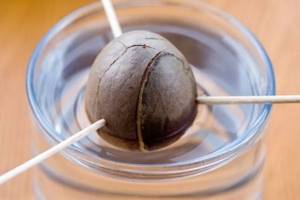
Attention! You can replace water with hydrogel.
Conditions for growing indoor avocado
For good growth of avocados indoors, you must follow several recommendations:
- The avocado pot must be placed on the sunny side, since under natural conditions the plant grows in hot climates.
- The tree needs sunlight for growth and development, but it must be shaded from direct sunlight to prevent burns on the leaves.
- In winter, additional lighting with fluorescent or phyto lamps is required. They are installed at a distance of approximately 40 cm from the plant and remain on for about 4 hours.
- Watering should be sufficient, at least 2 times a week. In winter, watering is reduced, but the soil is not allowed to dry out.
- Please note that when overwatered, the leaves turn yellow and fall off.
- Dry air negatively affects avocados, so the area around the tree must be constantly sprayed with water. It is ideal to place water in an open container nearby.
- Place the plant away from hot radiators, stoves, and electric heaters.
- To improve growing conditions, avocados are placed among similar large-leaved plants.
- Avocados do not like high temperatures. It is comfortable at 16-20 °C, and in winter 10-12 °C is enough.
- Indoor avocados may lose their leaves when winter sets in, but do not rush to throw them away, as they will come back to life in the spring.
- Avocados need regular feeding. In winter - once, in summer - a couple of times a month. For fertilizing, you need to use fertilizers intended for indoor plants.
Features of the conditions for growing aesthetic and fruitful avocados
For a tropical plant kept at home, an important factor is its external attractiveness. A bare stick with a top made of unhealthy leaves will not only not brighten up your home, but will also not produce the desired fruits. In this regard, responsible, competent care is decisive for the feasibility of home cultivation of avocados.

Avocados do not tolerate waterlogged soil, but drying out is also destructive. During the growth period, it is regularly watered, on average once a week or as the soil dries, during the dormant period - only after the soil has completely dried out. It is important to pay special attention to humidifying the air in the avocado growing room, ensuring regular spraying of the plant or having a container with moisture near the plant.
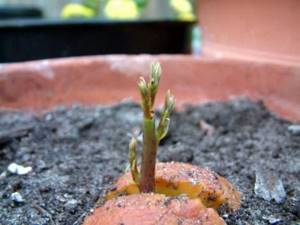
Lack of necessary moisture can lead to diseases, pests and leaf loss, which negatively affects not only the appearance, but also the ability to bear fruit.
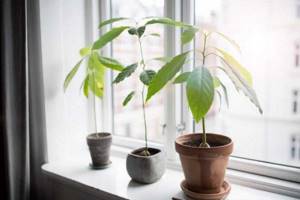
It is equally important to fertilize the plant in a timely manner with special products that are widely available on sale. Fertilizing should be carried out only during the growth period in the volume and frequency indicated on the packaging of the fertilizers used for tropical plants.

Application of the above recommendations will ensure the successful cultivation of avocados as a home decoration, an exciting hobby and a source of exotic delicacy.
Soil and pot for avocado at home
The soil in which it grows is of great importance for the development and growth of a plant. Specifically for avocados, you need any loose and light soil, but not sour soil. It would be good to add wood ash or dolomite flour to such soil.
The soil for avocado should be neutral (pH = 7), we repeat - just not sour. Use gravel or expanded clay for drainage.
You can prepare a soil mixture that is healthy for avocados yourself. For this you will need: peat (or humus), garden soil and coarse river sand. All components must be mixed in equal parts.
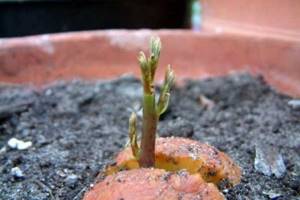
Under good conditions, the avocado sprout develops quickly
When the plant has just taken root, it is enough to plant it in a small container, for example, a cut-off 1.5 liter plastic bottle. When the avocado grows and leaves appear on it, you can transplant it into a suitable pot.
Tips for choosing a pot for indoor avocado:
- You don’t need to take a huge pot right away, as this will cause the plant to stretch upward more strongly.
- It is better to replant regularly as the tree matures.
- The pot should be chosen to be elongated in height - the root system of the plant goes deep into the soil, and does not grow in breadth.
- Even an experienced gardener can accidentally pour water into a plant. Therefore, be sure to choose a container with a drainage hole at the bottom to remove excess moisture.
We recommend you read it! We hope you will be interested in learning:
How to grow a pineapple at home from the top so that it bears fruit
Planting and transplanting
For the first time, an avocado is planted from a glass of water (where the seed sprouted) into a small pot for rooting and the appearance of the first sprout. A cut-off plastic bottle or other similar elongated container (for example, from a pack of Pringles chips) is suitable for this.
Then, when the plant grows and gets stronger, leaves appear on it, the avocado can be transplanted into a larger pot. It will already be necessary to lay drainage made of expanded clay or broken bricks, with moss and sand on top.
- Remove the avocado from the previous container and carefully, without damaging the roots, place it in a new pot on a layer of drainage, moss and sand.
- Then add enough prepared soil so that the avocado pit just peeks out above the surface.
- Lightly tamp and pour well.
As with other plants, plan to plant and replant avocados in the spring months from March to May inclusive.
| ADVICE If you take the gifts of nature - moss from the forest, soil from the garden, sand from the local beach - do not forget to steam all the ingredients, pour boiling water on them, apply a biofungicide, in general, disinfect them in any available way. |
Avocado pot
When choosing a container for growing avocados, consider the following important points:
- The larger the container, the stronger the tree will grow and stretch upward. Therefore, if you do not want to get a clumsy giant, replant the plant gradually as it grows.
- An avocado pot needs to be long rather than wide. The avocado root goes deep, and the plant needs to provide this depth. Therefore, choose a floor container for growing avocados, especially when the tree grows to 1-1.5 m
- A pot with special drainage holes is best. After all, the tree loves moisture, but cannot tolerate stagnation of liquid and can easily rot. This is what happened with my first avocado, which could not withstand my love and care, and suddenly withered from excessive watering.
| BY THE WAY Now my avocado is a little over six months old (from the moment it was planted in the pot), it is approx. 80 cm (after two pinchings) and grows in a pot with a diameter of 23 cm and a height of 22 cm. |
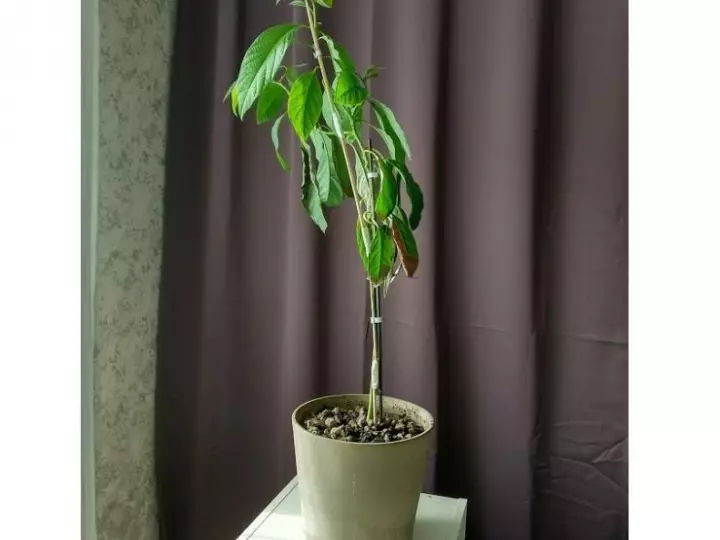
Photo: my avocado also needed support, otherwise the trunk stubbornly leans to the right
What soil to prepare
Choose well-drained and fertile soil for avocados. You can prepare the soil mixture in the following proportions:
- 2 parts of turf land,
- 1 part sand
- 1 part humus.
Or: leaf soil, peat and sand in equal proportions.
When purchasing or preparing a soil mixture for planting avocados, consider:
- The soil should be ventilated, fertile, loose, and retain moisture well;
- The soil should not be acidic,
- Avocados will really like the presence of moist moss and sand in the soil mixture.
| BY THE WAY My avocado grows in regular garden soil. I generously laid drainage at the bottom of the pot (at least 2/3 of the volume). I mulched the top layer of soil with pebbles - such mulch looks decorative and retains moisture. Although the best moisture-saving mulch for avocados would be moss or stone chips. In addition, mulch protects moist soil from the dominance of house flies, especially during the cold season. |
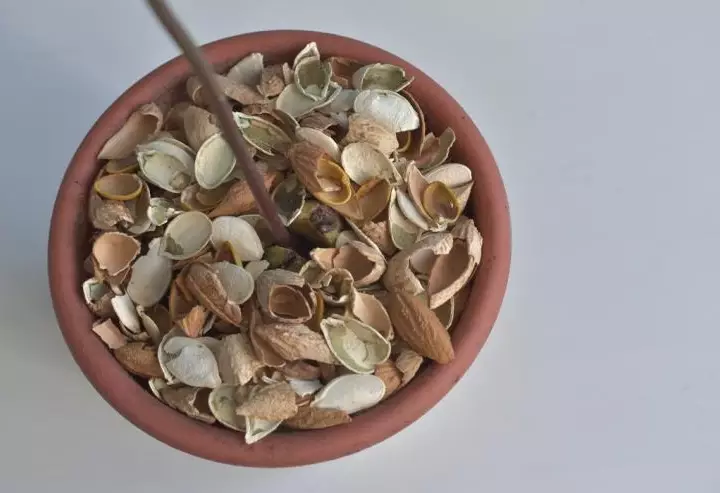
Photo: mulch made from nut shells and pumpkin seeds
Location and temperature
Since the avocado is native to the tropics, it is natural that the plant loves warmth. In the event of a sharp drop in temperature or the slightest draft, the tree begins to show its dissatisfaction - all the leaves will fall off immediately. Therefore, even in warm summer weather, it is not advisable to take it outside.
And the room must also maintain a constant temperature. In the warm season, high room temperature will be favorable for avocados, but in the cold winter, 20 degrees Celsius will be enough for it.
The plant also has a dormant period in winter. If in winter the indoor temperature drops to 12 degrees, the avocado will immediately react - shed its leaves and switch to hibernation mode. But with proper care and constant temperature balance, this cannot happen. This tropical plant is considered evergreen.
How to properly water homemade avocados
The plant should be watered abundantly to prevent the soil from drying out. Overwatering is no less dangerous: the roots will begin to rot and the avocado will die.
- After watering, you need to monitor the top layer of soil. When it has dried, you should wait another 1-2 days: the deeper layers of the soil still retain the necessary moisture to support growth.
- In summer, the plant is watered more often than in winter, when daylight hours are reduced.
- Watering is carried out exclusively with soft, settled water.
Avocados do not tolerate dry air well, so it is necessary to spray the area around the plant with a spray bottle 1-2 times a day. This is especially important in winter, when the indoor air becomes dry due to central heating and space heaters.
You should spray the leaves or flowers themselves with extreme caution, making sure that no burns occur. During the heating season, spraying often does not give the desired effect, so it is advisable to install an air humidifier in the room. This will benefit not only avocados, but also other indoor plants. Recommended air humidity should be 50-70%.
How to care for an avocado
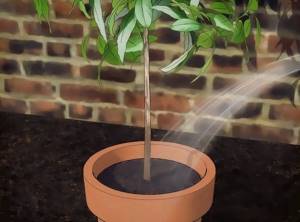
It should be remembered that the plant also does not like excessive watering.
To avoid excess moisture in the pot, in winter you need to wait until the soil is completely dry and only then water it. You can determine the level of soil dryness by deepening your finger 2–3 cm into the soil.
In the summer, the plant should be watered no more than 1 – 2 times a week. For irrigation, settled water at room temperature is used.
In winter, the plant needs to artificially increase daylight hours with fluorescent lamps to 12 hours, and during the flowering period, avocados need 15 hours of sunlight.
Every year it is recommended to transplant this fruit tree into a larger container with partial replacement of the soil. The recommended time for this manipulation is the beginning of spring.
Priming
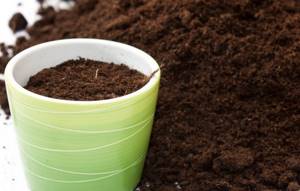
To successfully grow avocados, you need special soil. It is necessary to add drainage to the bottom of the pot where the plant is planned to be planted. Next, light, breathable soil is poured. It should be loose.
You can buy ready-made soil in the store, but it’s not difficult to prepare it yourself.
For this you will need:
- sand;
- humus;
- ordinary soil from the garden;
- peat;
- for looseness - moss;
- fine expanded clay.
Mix all the ingredients thoroughly and the soil for planting is ready. Pour the prepared soil into the pot, leaving 1-2 cm of free space at the top edge.
Top dressing
When your houseplant celebrates its first birthday, you can start feeding it with mineral fertilizers. Feeding, as a rule, is carried out 4 times a year - in the spring and summer, every 1.5 - 2 months.
If the tree is already at an advanced age, then an additional portion of nitrogen fertilizers is needed, which are applied to the soil 2 times a year - at the end of winter and beginning of summer.
Trimming

Usually in the summer, avocados begin to grow rapidly upward. To avoid this and slow down the growth process, the top must be trimmed or pinched by 10 - 15 cm. Pruning should be carried out in the spring, before the period of rapid growth begins. After this manipulation, the formation of lateral shoots is observed. In winter, the growth of the plant stops and it begins to hibernate. This is absolutely normal.
Forming a braid

When braiding a braid, it is important not to damage the trunk of the plant.
In order to form a braid of avocado plants, you need to plant at least three seeds in one pot. As the plant grows, you can braid it loosely, leaving gaps between the braids. As the trunks thicken, these gaps will disappear.
The braid can be fixed with wire. Since the young trunks of the plant are very flexible, it will not be difficult to braid a pigtail from them. Over time, an original and beautiful tree emerges.
Fertilizer application
For an avocado growing in unusual apartment conditions, feeding is mandatory, otherwise it will not feel comfortable. Unlike a tree living in its natural environment, it does not receive useful minerals from precipitation, the soil is not loosened by earthworms, and the soil is not renewed naturally.
For optimal plant growth, liquid mineral fertilizers sold in stores and mixtures for citrus fruits are suitable. In this case, it is advisable to slightly reduce the recommended dose from that specified by the manufacturer.
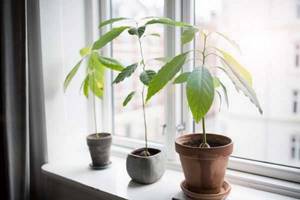
Formation of an avocado tree
Tips for feeding indoor avocados:
- They usually fertilize twice a month from March to August. In autumn and winter, there is no need to feed avocado: its active growing season stops and a dormant period begins.
- Sometimes avocados need organic fertilizers: manure, humus, peat, bird droppings. A simpler option is infusions of onion peels and egg shells.
- Fertilizers can be either applied to the soil or sprayed on the foliage.
Trimming and pinching, crown formation
To ensure that the plant does not stretch in height, but acquires splendor in the form of side shoots, it must be pinched. This procedure can be carried out only when the tree has a sufficient number of leaves (at least eight). First, pinch the top of the plant, this promotes the development of side branches. And after they are sufficiently formed and have their own leaves, you can pinch them too.
Without pruning, the tree will not be attractive. It is necessary to constantly form the crown. For this purpose, spring pruning is carried out. In the first year of growth, the main stem is cut above the 7-8 leaf blade, the lateral stems - above the 5-6th. In subsequent years, pruning helps maintain the desired height.
You can plant several avocado seeds in one pot at once, and after they germinate and grow, the stems of the plants can be woven, but not very tightly, leaving room for the stems to grow and thicken. The result will be a very original plant. How to do this correctly, watch the video:
Pest and disease control
Avocado, like all indoor plants, is afraid of the same pests - scale insects and spider mites. The voracious spider mite can not only destroy all the leaves on the plant, but can also transmit various diseases to other indoor flowers. The scale insect feeds on plant sap. After its appearance, only dry leaves remain.
You can fight such pests with various traditional methods or insecticidal preparations. Among diseases, the main danger to avocados is powdery mildew.
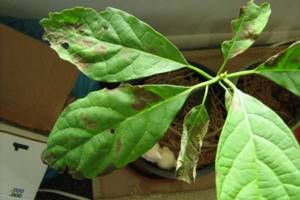
Indoor avocado is sick due to non-compliance with the rules of caring for it
Other problems may arise during the growing process:
- The tips of the leaves dry out. The reason is that watering rules are not followed (lack of moisture), insufficient air humidity. It is necessary to establish regular watering (only after the top layer of soil has dried) and humidify the air in the room using spraying.
- Leaves are falling. The reason is drafts and a decrease in air temperature in the apartment. It is necessary to maintain optimal temperature conditions in the room and avoid drafts.
- Pale leaves. The reason is lack of lighting. It is necessary to find a suitable place for the plant or organize additional (artificial) lighting for it, especially in winter.
Features of cultivation
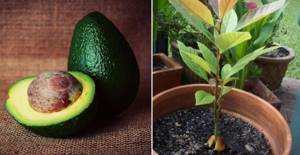
With proper planting and care, you can grow a full-fledged plant.
Growing avocados from seeds at home is a fascinating activity for people who enjoy doing home gardening. In order for this plant to decorate your home, it is not at all necessary to have an agronomist diploma.
What you need to know in advance:
- this fruit grows and develops well in the presence of sufficient sunlight, that is, you need to prepare a place for it on the sunny side of your apartment;
- he is very afraid of drafts, so in winter it is not recommended to open windows near tender avocado sprouts;
- This plant naturally grows in humid climates, so at home it needs to be provided with conditions as close as possible to its climate. You will have to humidify the air in the room, since dry air threatens to shed leaves;
- moderate watering is very important, the soil should be slightly moist;
- the air temperature in the room should not be lower than 16 degrees.
For a quick and correct process of avocado growth, it is very important to follow all the above rules and the result will not be long in coming.
To grow an avocado from a seed, you need to take the following steps:
- To purchase the fruit itself in the store directly, it must be ripe and undamaged. Ripeness is checked by slightly pressing the fruit with light pressure. If you cannot find a ripe fruit, then wrap the unripe fruit in newspaper and put it in a dark place or put a couple of apples in a bag with avocado, and after two days you can enjoy the most delicate, oily pulp.
- Remove the bone. To do this you will need a sharp knife. Carefully make a cut along the entire fruit and remove a fairly large stone.
- It is recommended to wipe the seed to remove white deposits; if desired, you can remove the shell.
Avocado transplant rules
Domestic avocados need to be replanted regularly, but if you want to limit its height, when replanting, use the same pot, changing only the soil. In this case, it is necessary to trim the crown and compensate for the limited volume of soil with fertilizing.

How to grow an avocado from a seed at home
What to do if you cannot replant the plant every year? To prevent the tree from suffering from salinity, it is necessary to replace at least the top layer of soil, and the rest of the soil should be well watered with boiled water.
Attention! Avocado leaves, peel and seeds contain the toxic substance persin. It causes an allergic reaction and digestive disorders, so carry out all transplant work with gloves and generally take precautions.
The recommended method of transplantation is transshipment. With this method, the plant is literally “dumped” together with a lump of earth into a new, larger pot. This must be done carefully, trying not to damage the shoots and roots of the fragile young tree. The voids are filled with fresh soil.
The requirements for preparing the substrate and pot are the same as for planting: the container has a drainage hole, and expanded clay must be placed on the bottom. If the avocado was watered shortly before transplanting, you don’t have to water it immediately, but wait a few hours.
Preparing to cultivate avocados at home
In order to grow a tropical avocado as a healthy and fruitful plant with an aesthetic appearance, you must first take into account a number of circumstances under which such an effect is achieved in nature.
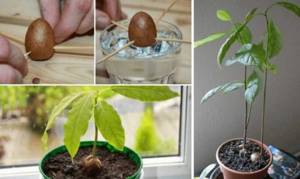
Firstly, before growing an avocado at home, you should evaluate the possibility of providing in the future for a fairly large adult plant (and this is a tree that reaches a height of 2.5-3 m at home) with sufficient light space in the room for its maintenance.
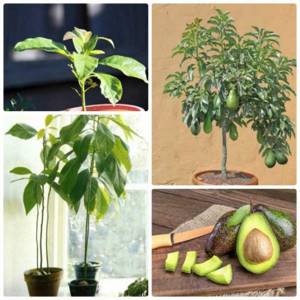
Avocados love a lot of light, but do not tolerate direct sunlight, which causes burns on the leaves.
In addition, this plant does not tolerate drafts, and is also demanding on temperature conditions and air humidity. For normal growth, an air temperature of 22-25 degrees is required, and in the autumn-winter period -14-18 degrees Celsius. Tropical avocados do not tolerate sudden temperature fluctuations and love high humidity.
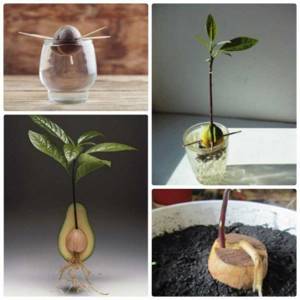
If all these conditions characteristic of its natural environment are not met, the avocado leaves wither, dry out and fall off, and sometimes the plant as a whole dies.
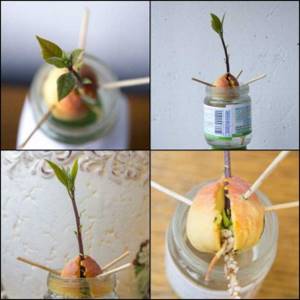
Secondly, you should start growing in the spring, when, with a gradual increase in daylight hours, the greatest activity is observed in awakening the vital forces of all plants. This will ensure the maximum rate of seed germination and prevent its deterioration due to prolonged stagnation at the initial stage.
Also, on the surface of a well-ripe avocado, when pressed, dents are formed, which immediately disappear when released.
